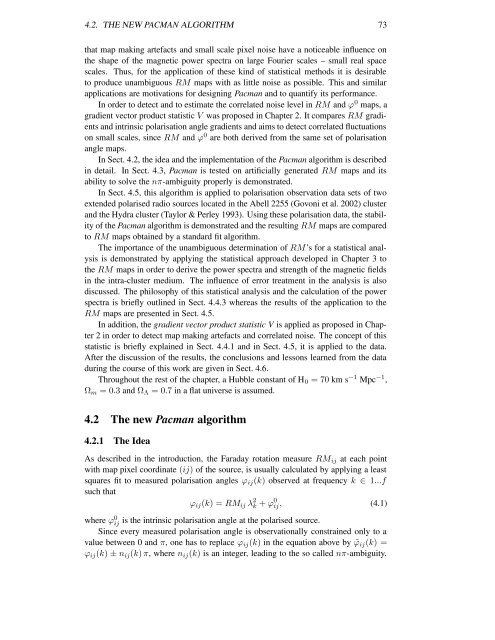Investigations of Faraday Rotation Maps of Extended Radio Sources ...
Investigations of Faraday Rotation Maps of Extended Radio Sources ...
Investigations of Faraday Rotation Maps of Extended Radio Sources ...
Create successful ePaper yourself
Turn your PDF publications into a flip-book with our unique Google optimized e-Paper software.
4.2. THE NEW PACMAN ALGORITHM 73<br />
that map making artefacts and small scale pixel noise have a noticeable influence on<br />
the shape <strong>of</strong> the magnetic power spectra on large Fourier scales – small real space<br />
scales. Thus, for the application <strong>of</strong> these kind <strong>of</strong> statistical methods it is desirable<br />
to produce unambiguous RM maps with as little noise as possible. This and similar<br />
applications are motivations for designing Pacman and to quantify its performance.<br />
In order to detect and to estimate the correlated noise level in RM and ϕ 0 maps, a<br />
gradient vector product statistic V was proposed in Chapter 2. It compares RM gradients<br />
and intrinsic polarisation angle gradients and aims to detect correlated fluctuations<br />
on small scales, since RM and ϕ 0 are both derived from the same set <strong>of</strong> polarisation<br />
angle maps.<br />
In Sect. 4.2, the idea and the implementation <strong>of</strong> the Pacman algorithm is described<br />
in detail. In Sect. 4.3, Pacman is tested on artificially generated RM maps and its<br />
ability to solve the nπ-ambiguity properly is demonstrated.<br />
In Sect. 4.5, this algorithm is applied to polarisation observation data sets <strong>of</strong> two<br />
extended polarised radio sources located in the Abell 2255 (Govoni et al. 2002) cluster<br />
and the Hydra cluster (Taylor & Perley 1993). Using these polarisation data, the stability<br />
<strong>of</strong> the Pacman algorithm is demonstrated and the resulting RM maps are compared<br />
to RM maps obtained by a standard fit algorithm.<br />
The importance <strong>of</strong> the unambiguous determination <strong>of</strong> RM’s for a statistical analysis<br />
is demonstrated by applying the statistical approach developed in Chapter 3 to<br />
the RM maps in order to derive the power spectra and strength <strong>of</strong> the magnetic fields<br />
in the intra-cluster medium. The influence <strong>of</strong> error treatment in the analysis is also<br />
discussed. The philosophy <strong>of</strong> this statistical analysis and the calculation <strong>of</strong> the power<br />
spectra is briefly outlined in Sect. 4.4.3 whereas the results <strong>of</strong> the application to the<br />
RM maps are presented in Sect. 4.5.<br />
In addition, the gradient vector product statistic V is applied as proposed in Chapter<br />
2 in order to detect map making artefacts and correlated noise. The concept <strong>of</strong> this<br />
statistic is briefly explained in Sect. 4.4.1 and in Sect. 4.5, it is applied to the data.<br />
After the discussion <strong>of</strong> the results, the conclusions and lessons learned from the data<br />
during the course <strong>of</strong> this work are given in Sect. 4.6.<br />
Throughout the rest <strong>of</strong> the chapter, a Hubble constant <strong>of</strong> H 0 = 70 km s −1 Mpc −1 ,<br />
Ω m = 0.3 and Ω Λ = 0.7 in a flat universe is assumed.<br />
4.2 The new Pacman algorithm<br />
4.2.1 The Idea<br />
As described in the introduction, the <strong>Faraday</strong> rotation measure RM ij at each point<br />
with map pixel coordinate (ij) <strong>of</strong> the source, is usually calculated by applying a least<br />
squares fit to measured polarisation angles ϕ ij (k) observed at frequency k ∈ 1...f<br />
such that<br />
ϕ ij (k) = RM ij λ 2 k + ϕ 0 ij, (4.1)<br />
where ϕ 0 ij is the intrinsic polarisation angle at the polarised source.<br />
Since every measured polarisation angle is observationally constrained only to a<br />
value between 0 and π, one has to replace ϕ ij (k) in the equation above by ˜ϕ ij (k) =<br />
ϕ ij (k) ± n ij (k) π, where n ij (k) is an integer, leading to the so called nπ-ambiguity.
















